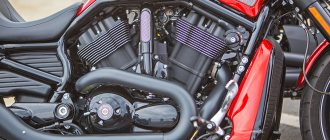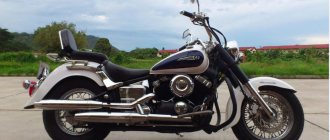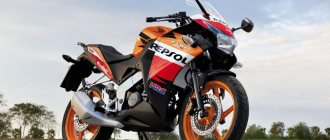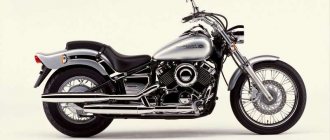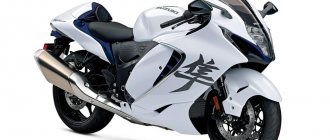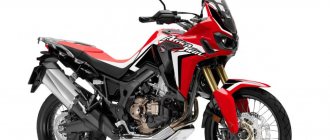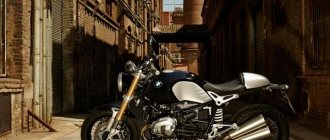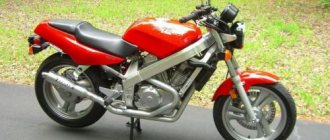| Honda Shadow 600 VLX (1988-2007) | Honda Shadow 600 VLX Deluxe (1993-2007) |
Cruiser model Honda Shadow 600
appeared in 1988 in parallel with the Honda Steed 600, in contrast to which it was focused exclusively on foreign markets - mainly Europe, North America and Australia.
The factory designation for the Shadow 600 is VT600C
;
Steed 600 - NV600C
. Both models are almost identical to each other, but differ in engine settings (Shadow is more powerful), saddle, trim levels and changes over the years.
Main modifications of the Honda Shadow 600:
- Honda VT600C Shadow VLX
- regular version. - Honda VT600CD Shadow VLX Deluxe
- version in chrome package. It features chrome valve covers, a more comfortable double seat, a chrome trim on the rear fender and the shape of the rear fender itself (double camber). Available only for the US market since 1993.
Since 1994, the Honda Shadow 600 model has received a larger fuel tank (9.0 l -> 11.0 l), and since 1995 a slight reduction in power (41 hp -> 39 hp) and a new, wider steering wheel. Since 1999, the Shadow 600 VLX has had one carburetor instead of two, which simplifies design and maintenance, and also makes the motorcycle even more similar to American models.
Since 2000, updated environmental regulations for European countries have come into force, due to which the model officially leaves this market, continuing to be produced and sold for the North American market. Only in 2008 did the Honda Shadow 600 VLX finally leave the assembly line and end its story.
The Honda Shadow 600 model is not very popular on the Russian market. This is due to the wider availability of the Japanese version of the Steed 600, as well as the high cost (especially the American Shadow 600 VLX of the 2000s), making the purchase of the Shadow almost impractical.
The main competitors of the Honda Shadow 600 in the class:
- Kawasaki Vulcan 500 LTD
- Suzuki VS600 Intruder
- Yamaha XV 535 Virago
- Yamaha XVS 650 Drag Star
Brief history of the model
- 1988 - start of production and sales of the Honda Shadow 600 VLX.
Model
: Honda Shadow 600 VLX (Europe, North America, Australia).
Factory designation
: VT600CJ.
- 1989 - no significant changes.
Model
: Honda Shadow 600 VLX (Europe, North America, Australia).
Factory designation
: VT600CK.
- 1990 - no significant changes.
Model
: Honda Shadow 600 VLX (Europe, North America, Australia).
Factory designation
: VT600CL.
- 1991 - no significant changes.
Model
: Honda Shadow 600 VLX (Europe, North America, Australia).
Factory designation
: VT600CM.
- 1992 - no significant changes.
Model
: Honda Shadow 600 VLX (Europe, North America, Australia).
Factory designation
: VT600CN.
- 1993 - appearance of the Deluxe modification.
Model
: Honda Shadow 600 VLX;
Honda Shadow 600 VLX Deluxe (Europe, North America, Australia). Factory designation
: VT600CP; VT600CDP.
- 1994 - the model receives an increased fuel tank to 11 liters.
Model
: Honda Shadow 600 VLX;
Honda Shadow 600 VLX Deluxe (Europe, North America, Australia). Factory designation
: VT600CR; VT600CDR.
- 1995 - The model receives a wider steering wheel and reduces maximum power to 39 hp.
Model
: Honda Shadow 600 VLX;
Honda Shadow 600 VLX Deluxe (Europe, North America, Australia). Factory designation
: VT600CS; VT600CDS.
- 1996 - no significant changes.
Model
: Honda Shadow 600 VLX;
Honda Shadow 600 VLX Deluxe (Europe, North America, Australia). Factory designation
: VT600CT; VT600CDT.
- 1997 - front suspension travel is reduced to 120 mm.
Model
: Honda Shadow 600 VLX;
Honda Shadow 600 VLX Deluxe (Europe, North America, Australia). Factory designation
: VT600CV; VT600CDV.
- 1998 - no significant changes.
Model
: Honda Shadow 600 VLX;
Honda Shadow 600 VLX Deluxe (Europe, North America, Australia). Factory designation
: VT600CW; VT600CDW.
- 1999 - the model receives 1 carburetor instead of 2, and also slightly changes the weight and size characteristics. Last year of production for the European market.
Model
: Honda Shadow 600 VLX;
Honda Shadow 600 VLX Deluxe (Europe, North America, Australia). Factory designation
: VT600CX; VT600CD2X.
- 2000-2007 - without significant changes.
Model
: Honda Shadow 600 VLX;
Honda Shadow 600 VLX Deluxe (North America). Factory designation
: VT600C; VT600CD.
Specifications
Technical characteristics of Honda Shadow 600 VLX:
| Model | Honda VT600C Shadow VLX/Deluxe |
| Motorcycle type | cruiser |
| Year of issue | 1988-2007 |
| Frame | steel tubular |
| engine's type | 2-cylinder, 4-stroke, V-shaped |
| Working volume | 583 cm³ |
| Bore/Stroke | 75.0 x 66.0 mm |
| Compression ratio | 9.2:1 |
| Cooling | liquid |
| Number of valves per cylinder | SOHC, 3 valves per cylinder |
| Fuel supply system | carburetor, 2x Keihin 34 mm - VT600C ('88-'98) carburetor, 1x Keihin 34 mm - VT600C ('99-'07) |
| Ignition type | transistor |
| Maximum power | 41.0 hp (30.15 kW) at 6500 rpm - VT600C ('88-'94) 39.0 hp (28.68 kW) at 6500 rpm – VT600C ('95-'07) |
| Maximum torque | 51.0 Nm (5.2 kg*m) at 3500 rpm - VT600C ('88-'94) 48.8 Nm (4.9 kg*m) at 3300 rpm - VT600C ('95-' 07) |
| Clutch | Multi-disc in oil bath, cable drive |
| Transmission | 4-speed |
| type of drive | chain |
| Front tire size | 100/90-19 (57S) |
| Rear tire size | 170/80-15 M/C (77S) |
| Front brakes | 1 disc, 296 mm, 2-piston caliper |
| Rear brakes | drum, 160 mm |
| Front suspension | 39mm Telescopic Fork, 146.5mm Travel - VT600C ('88-'96) 39mm Telescopic Fork, 120.0mm Travel - VT600C ('97-'07) |
| Rear suspension | pendulum with monoshock absorber (preload adjustment), stroke - 90 mm |
| Motorcycle length | 2310 mm |
| Motorcycle width | 760 mm – VT600C ('88-'94) 890 mm – VT600C ('95-'98) 880 mm – VT600C ('99-'07) |
| Motorcycle height | 1125 mm – VT600C ('88-'98) 1120 mm – VT600C ('99-'07) |
| Wheelbase | 1605 mm – VT600C ('88-'98) 1600 mm – VT600C ('99-'07) |
| Seat height | 680 mm |
| Minimum ground clearance (clearance) | 140 mm – VT600C ('88-'98) 135 mm – VT600C ('99-'07) |
| Acceleration 0-100 km/h (0-60 mph) | 8.34 sec[1] |
| Maximum speed | 145 km/h[2] |
| Gas tank capacity | 9.0 l (including reserve - 1.9 l) - VT600C ('88-'93) 11.0 l (including reserve - 3.4 l) - VT600C ('94-'07) |
| Motorcycle weight (dry) | 196 kg – VT600C ('88-'93) 199 kg – VT600C ('94-'98) 205 kg – VT600C ('99-'07) 202 kg – VT600C Deluxe ('94-'98) 208 kg – VT600C Deluxe ('99-'07) |
| Motorcycle weight (curb) | 207 kg – VT600C ('88-'93) 213 kg – VT600C ('94-'98) 214 kg – VT600C ('99-'07) 216 kg – VT600C Deluxe ('94-'98) 217 kg – VT600C Deluxe ('99-'07) |
Test drive HondaShadow 400, SuzukiIntruder Classic 400, YamahaDrag Star Four
Season. Warm. Do you have some money for a good second? Question: “To be or not to be?” not worth it. Of course there will be! I want to ride! Question two: should I give you the form or the content for your money? Don't kid yourself, most people choose the form. External show-off is still more expensive than money, otherwise tuning would begin in our country not with a body kit, chrome and plastic, but as all over the world - with turning the engine inside out. So, the more posh, the more prestigious. Form - to be! We are reviewing a number of cruisers “for beginners”, the youngest, so to speak, size.
It is represented by “four hundred” models, which are actually sold on the Ukrainian secondary market. These are Honda Shadow, Yamaha DragStar and Suzuki Intruder Classic.
What do all these motorcycles have in common? They are about the same price and for the good condition in which they are, it is just right. Outwardly, they are all very similar, only minor differences are striking. What makes them different for the average person is the extensive catalog tuning. But not for the average person?
So, in order:
Honda: water cooling, radiator filler cap hidden under plastic near the steering column. Size and dimensions: it is as big as the 750 cc version. Chain drive to the wheel? This is not for everyone. There are no very strong arguments “for” and “against”. Let's put it this way: you should immediately leave room in the glove compartment under the seat for a bottle of lubricant. Plus, you need to tighten the chain periodically, and the frequency directly depends on your driving style. The landing, in my opinion, is not entirely comfortable; you can move the footrests a little further, or install platforms, then you can put your foot in different positions. But this is already tuning. The seat is standard, you don’t feel any discomfort, but there isn’t much satisfaction from the seating either. Everything is simple, good and neat. The steering wheel is also standard, the hands are quite comfortable, and there is a decent view in the mirrors.
The speedometer, like everyone else, is on the tank. There is also a neutral light bulb. I take off, accelerate, the motorcycle confidently picks up “a hundred” in third gear. What can I say, the wind in your face on a cruiser is normal. Its cruising speed with a full load is 120. At the same time, it will not blow away, but if you dial and constantly keep it at “140” or more, then you can forget about comfort. There is no point in looking for cons in this motorcycle. With a height of up to 180 cm, it will be comfortable for anyone, whether you have 60 liters of displacement or 160, and walking around the city at a speed of 60 km/h will bring joy and pleasure. The motorcycle is very unpretentious in terms of service; there is a great selection of tuning and consumables for it in the catalogs, both original and licensed, so there shouldn’t be any problems. Also, unlike Yamaha, the engine is not loaded with decorative plastic trims and anything else; the motorcycle is simple. Regarding other points: the gearbox does not raise any questions, and the engine turns the way you turn it. I’m describing this device first because it’s simply solid, it didn’t leave any enthusiastic opinions about itself, it’s just a good option for everyday driving or a Sunday fashion show.
Yamaha: seat, leg extension and landing can already be compared. The motorcycle is more comfortable to sit on, and it’s noticeable. The legs are in place, and sitting is more pleasant. Whether it’s a liter or a 400, I don’t see any difference. The steering wheel is the same as on the Honda, the same convenience, the speedometer is on the tank, the mirrors are in place. Speed up to 40 km/h is not surprising. They're the same color, but the position of your feet on the pegs means you're on a different bike. Another drive to the wheel is a cardan. This is probably a plus; for lazy people, this is a very compelling argument. It’s not so hot here and there are no long climbs to worry about the air cooling of the engine, and I haven’t heard of it overheating. So the absence of a radiator is another plus for lazy people; replacement of antifreeze is not required. As usual, there was a fly in the ointment here, although these are the little things in life.
Thus, the engine, descended from the high-quality V-drive XV 400/535, tested by time and Japanese typhoons, is not reliable, unlike the latter. The culprit is electrical problems, in particular the electric starter and battery. As for the transmission, competitors are left fuming nervously: they still need to look for something comparable in reliability. The frame is not chopper-like rigid, but this advantage is partially offset by the large inclination of the fork, which causes some rolliness in corners. And one more thing about suspensions: you often come across examples with current forks. As for the rear, it is a bit harsh, and other examples come from Japan without a rear shock absorber at all, a kind of tuning “hardtail,” so you should carefully inspect the device you choose.
But Suzuki is not the middle, but certainly a golden example. It's not a Cruiser - it's just a Liner. It is an order of magnitude better than both Shadow and DragStar. Outwardly, he is just as large, just as stylish, but when I sat on him, he seemed even larger and more mature. It is very comfortable, and for me, the comfort it provides deserves 5 stars. If desired, he can install a windshield and drive non-stop until his “retirement”. Probably, if the first two can be used for long-distance travel and from a cafe to a cinema, this one can and should be used to drive and refuel on the go, there are simply no other options! It captivates so much with its comfort and the thrill of driving that you don’t have the slightest desire to stop for tea in a cafe, you don’t want to get off it at all! It's just some kind of magic. Cardan drive, water cooling - these are advantages! The steering wheel and mirrors are the same as those of competitors, but it is more comfortable to sit and drive. And it picks up speed quite quickly, although on such and such a chariot I would like it to be faster. The fifth overdrive generally brings the bike down, so it's better to work more actively with the first four. Cruising speed is the same as that of competitors, but the speed with luxury comfort and just speed is already a reason to talk and brag a lot at the next gas station or cafe. My head doesn’t hurt about either the gearbox or the chassis (although the frame could be stiffer). Everything works, nothing breaks or knocks. Everything is perfect, the motorcycle holds its course perfectly, but you shouldn’t overdo it with speed: its element is cruise mode.
It's difficult to summarize. This trio has an indescribable aura and looks “at 100”; only an experienced eye can spot 400 in these beauties. A sea of style for relatively little money - that’s also about them. However, as always, disadvantages are a continuation of advantages. The engine power is sufficient and no more (see weight/power ratio), and if during leisurely riding this does not bother you, then on the highway when overtaking another truck it is worth measuring seven times... None of the tested models cause serious problems for the owner due to breakdowns, otherwise If something breaks, it can be attributed to the carelessness of the previous owner or minor design flaws. All three have an energy-intensive, modern suspension that makes the ride comfortable. It's true that a leaking fork and a stiff rear shock put the Yamaha in third place in this regard, but it wins back thanks to its lively engine. The Honda is probably the most balanced bike of the trio, although this also makes it a little faceless, without any flair. Motorcycles often undergo quite deep tuning “there”, so you should be careful when choosing. If your chopper is pristine, then thick catalogs of tuning accessories will help you personalize it as much as possible.
With all their grandeur, motorcycles do not provoke you to spin madly and fly with bulging eyes, but you can say with all confidence that they are needed only to deliver all the polished beauty of the tank and wings, you and your friend along the embankment from cafe to cafe . These are motorcycles for those who love pathos. These are motorcycles for those who like to look at how the lights of the city at night are reflected in the perfectly polished surface of the tank. Be in shape!
Text: Alexey CASH
Height: 175cm. Weight: 82 kg.
Drives: Honda Steed 600 (custom).
Photo: Anatoly Eremeev DESIGNER
